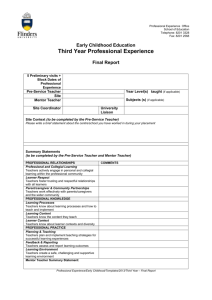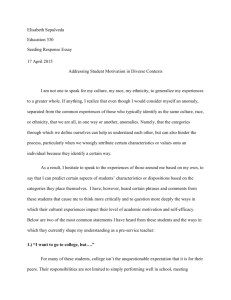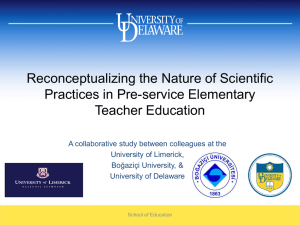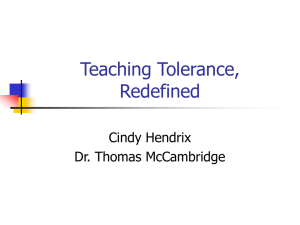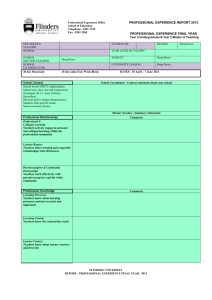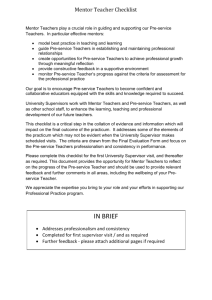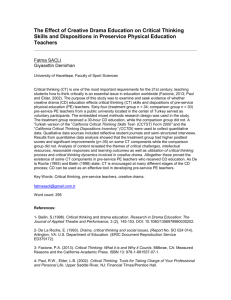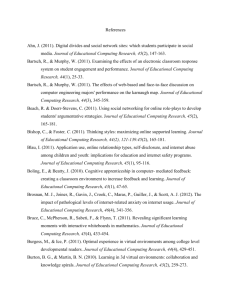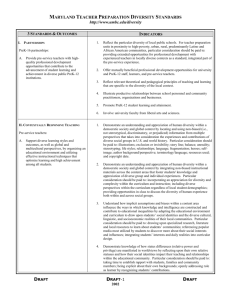Section 5: Learning Center Activities
advertisement
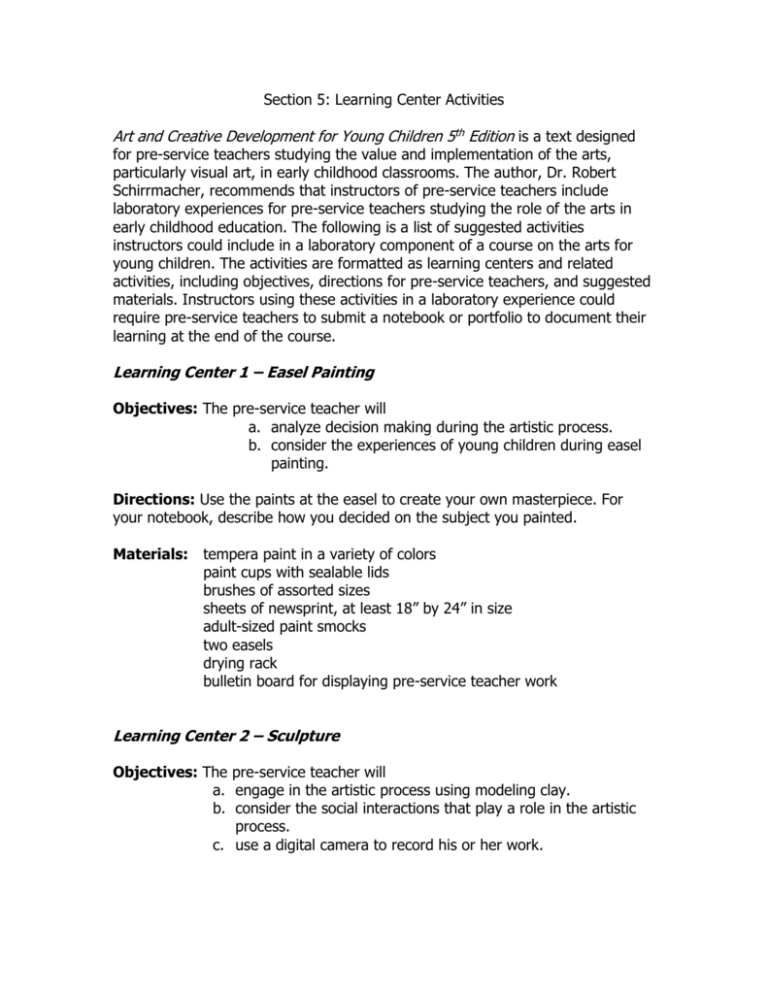
Section 5: Learning Center Activities Art and Creative Development for Young Children 5th Edition is a text designed for pre-service teachers studying the value and implementation of the arts, particularly visual art, in early childhood classrooms. The author, Dr. Robert Schirrmacher, recommends that instructors of pre-service teachers include laboratory experiences for pre-service teachers studying the role of the arts in early childhood education. The following is a list of suggested activities instructors could include in a laboratory component of a course on the arts for young children. The activities are formatted as learning centers and related activities, including objectives, directions for pre-service teachers, and suggested materials. Instructors using these activities in a laboratory experience could require pre-service teachers to submit a notebook or portfolio to document their learning at the end of the course. Learning Center 1 – Easel Painting Objectives: The pre-service teacher will a. analyze decision making during the artistic process. b. consider the experiences of young children during easel painting. Directions: Use the paints at the easel to create your own masterpiece. For your notebook, describe how you decided on the subject you painted. Materials: tempera paint in a variety of colors paint cups with sealable lids brushes of assorted sizes sheets of newsprint, at least 18” by 24” in size adult-sized paint smocks two easels drying rack bulletin board for displaying pre-service teacher work Learning Center 2 – Sculpture Objectives: The pre-service teacher will a. engage in the artistic process using modeling clay. b. consider the social interactions that play a role in the artistic process. c. use a digital camera to record his or her work. Directions: Use the materials provided to sculpt your own masterpiece. Take a photo of your masterpiece with the digital camera. Include the photo in your notebook, along with a description of the social interactions that occurred in this center while you were working. Materials: modeling clay in assorted colors work table tools for sculpting (plastic forks and knives, rolling pins, etc.) digital camera computer and color printer for digital photos Learning Center 3 – Biographical Timeline Objectives: The pre-service teacher will a. acquire basic biographical information on a masterpiece artist or major composer from a variety of sources. b. organize that information in chronological order. Directions: Select a visual artist or a musical composer and use the materials provided, as well as resources outside the classroom, to construct a timeline of major events in that person’s life. Materials: A collection of biographical materials, those designed for children’s and adult reading, should be provided. Learning Center 4 – Visual Art Trade Books Objectives: The pre-service teacher will a. become familiar with an array of children’s trade books that can be used to support art appreciation and production in an early childhood classroom. b. use art appreciation and production activities to support content learning in an early childhood classroom. Directions: Relax and enjoy some good books about visual art. Think about how you could use these books in your classroom. Develop a lesson plan to teach age- or grade-level content using one of these trade books. Base your lesson plan on state standards in mathematics, science, social science, and/or language arts. Materials: a recommended lesson plan format by which pre-service teachers will develop their own lesson plans book shelf for storing trade books comfortable seating for perusing books see the annotated bibliography of visual art and music trade books in Section 1 of this Online Companion Learning Center 5 – Music and Movement Trade Books Objectives: The pre-service teacher will a. become familiar with an array of children’s trade books that can be used to support music appreciation and production and movement activities in an early childhood classroom. b. use music and movement activities to support content learning in an early childhood classroom. Directions: Relax and enjoy some good books about music and movement. Think about how you could use these books in your classroom. Develop a lesson plan to teach age- or grade-level content using one of these trade books. Base your lesson plan on state standards in mathematics, science, social science, and/or language arts. Materials: a recommended lesson plan format by which pre-service teachers will develop their own lesson plans bookshelf for storing trade books comfortable seating for perusing books see the annotated bibliography of visual art and music trade books in Section 1 of this Online Companion Learning Center 6 – Teacher Resources Objective: The pre-service teacher will identify resources for developing and implementing arts-related activities in the early childhood classroom. Directions: Spend some time examining the resources in this center. In your notebook, record a few of your favorite ideas. Materials: bookshelves comfortable seating for perusing materials teacher resource materials such as the following: Chambers, J., Hood, M., & Peake, M. (1995). A work of art. Twickenham, UK: Belair Publications. Clarkin, M. A. (1994). National Gallery of Art activity book. New York: Harry N. Abrams. Kohl, M. F., & Solga, K. (1996). Discovering great artists. Bellingham, WA: Bright Ring. Lasky, L., & Mukerji, R. (1980). Art: Basic for young children. Washington, DC: National Association for the Education of Young Children. Levy, V. K. (1988). Let’s go to the art museum. New York: Harry N. Abrams. Libby, W. M. L. (2000). Using art to make art. Clifton Park, NY: Delmar Learning. Longley, L. (1996). Gaining the arts advantage: Lessons from school districts that value arts education. Washington, DC: Arts Education Partnership. Press. Sabbeth, C. (1998). Crayons and computers. Chicago: Chicago Review Van Gorp, L. (2001). Digital photography in the classroom. Westminster, CA: Teacher created materials. Learning Center 7 – Rhythm Band Objectives: The pre-service teacher will a. experiment with rhythm band instruments. b. develop a lesson plan using rhythm band activities to teach concepts from one or more of the academic content areas. Directions: Play with the instruments in this center. Think of some concepts related to age- or grade-level standards in the major content areas that you could teach effectively with rhythm band instruments. Develop a lesson plan that incorporates rhythm band activities. Materials: a recommended lesson plan format by which pre-service teachers will develop their own lesson plans rhythm band instruments (cymbals, tambourines, triangles, maracas, rhythm sticks, drums, etc.) Learning Center 8 – Collage Objectives: The pre-service teacher will a. participate in the creative process by creating a collage from varied materials. b. analyze decision making in the creative process. Directions: Use the materials provided to create a collage. Include the collage in your notebook, along with a description of the decision you made during the creative process. Materials: sheets of construction paper, 18” by 24” in size fabric scraps ribbon and trim scraps wallpaper scraps scissors glue Learning Center 9 – Computer Objectives: The pre-service teacher will a. explore arts-related software for use in an early childhood classroom. b. consider how that software could be used effectively in an early childhood classroom. Directions: Explore the arts-related software in this center. Develop ideas around how you could use several pieces in your classroom. Record your ideas for your notebook. Materials: computer compatible with the software provided Arts-related software such as the following: Crayola Make a Masterpiece® available from IBM® Create & Draw in Elmo’s World® available from Mattel® Magic Artist Studio® available from Disney® Kid Pix Studio® available from Broderbund® Orly’s Draw-A-Story® available from Broderbund® Sesame Street Create & Draw in Elmo’s World® available from Mattel® Sketchboard Studio® available from KB Gear InteractivE Great Museums of the World published by Countertop Art for the Ages published by Topics Virtual Art Museum published by Fogware Learning Center 10 – Games Objectives: The pre-service teacher will a. analyze arts-related games for use in an early childhood classroom. b. describe additional arts-related games that could be used in an early childhood classroom. Directions: Play the games in this center with a partner. Have fun! What other games could you design for your classroom? Record your ideas in your notebook. Materials: Go Fish for Art published by Birdcage Books Kid O’Cat published by Games of Art Gothic Scream published by Fliptomania! Fractiles–7 published by Fractiles Masterpiece published by Parker Brothers® Other instructor-made games such as memory or dominoes (made with art postcards) Learning Center 11 – Videos Objectives: The pre-service teacher will a. analyze arts-related videos for use in an early childhood classroom. b. consider how selected videos could be tied to curriculum in an early childhood classroom. Directions: Watch at least two of the videos in this center. What curriculum connections do you find? How would you introduce each to your students? Materials: television VCR or DVD player arts-related videos or DVDs for young children such as the following: Baby Van Gogh by Family Home Entertainment Baby Mozart by Family Home Entertainment Please Don’t Eat the Pictures: Sesame Street at the Metropolitan Museum of Art by Children’s Television Workshop Beethoven Lives Upstairs by The Children’s Group Fantasia by Walt Disney Learning Center 12 – Teacher Comments Objectives: The pre-service teacher will a. identify the elements of art in children’s artwork. b. use the guidelines in Chapter 15 to develop appropriate teacher comments for each piece of artwork. Directions: Look at the children’s artwork in Section 4 of the On-line Companion. Write an appropriate teacher comment for each. Include the teacher comments in your notebook. Materials: children’s artwork in Section 4 of the On-line Companion Learning Center 13 – Fingerpainting Objectives: The pre-service teacher will a. participate in the creative process by fingerpainting. b. explain the value of fingerpainting to children’s development and learning. Directions: Get messy! Have fun! Include your masterpiece in your notebook. Also, think about the value of fingerpainting for young children. Write a brief explanation for your notebook. Materials: fingerpaints of various colors fingerpaint paper table to use as a work surface Learning Center 14 – Drawing Objectives: The pre-service teacher will a. participate in the creative process by drawing. b. explain how young children’s drawings may be used to assess their learning. Directions: Use the materials provided to draw a picture of a subject of your choice. Reflect on the ways you could have children draw to share with you what they have learned in a particular lesson. Record your reflections in your notebook. Materials: manila or newsprint drawing paper (18” by 24”) crayons colored chalk colored pencils markers pastels table to use as work surface Learning Center 15 – Watercolors Objectives: The pre-service teacher will a. participate in the creative process by painting with watercolor paints. b. develop instructions for use with young children engaged in watercolor painting. Directions: Use the watercolor paints to create a masterpiece. What directions or training would you give children before you provide opportunities to paint with water colors? Record you ideas in your notebook. Materials: individual sets of watercolor paints cups of water assorted paintbrushes manila or newsprint paper (18” by 24”) table to use as work surface Learning Center 16 – Learning Center Design Objective: The pre-service teacher will use information from the text and from class discussions to develop a floor plan for an art and/or a music center in an early childhood classroom. Directions: On the graph paper provided, draw a floor plan for the art center and/or the music center you visualize in your classroom. Include your floor plans in your notebook. Materials: graph paper rulers pencils colored pencils Learning Center 17 – Classroom Music Objectives: The pre-service teacher will a. analyze various types and sources of music for use in an early childhood classroom. b. prepare a list of music sources for use in his or her own classroom. Directions: Review the language arts, math, science, and social standards for the age or grade level you would most like to teach. Make a list of music CDs or tapes that you plan to use to support lessons and activities related to these standards. Would you use this music during lessons, work time, or transitions? Consider CDs and tapes in your lab, those you have at home, or those from any other source. Include your list in your notebook. Materials: age- or grade-level content standards sample CDs or tapes of various types of music, including folk, classical, jazz, ethnic, and rock music Learning Center 18 – Blocks Objectives: The pre-service teacher will a. participate in the creative process by building with blocks. b. identify social skills used in cooperative block play. Directions: Choose a partner. Together design and build a structure with the blocks in this center. Discuss the social skills that you used in this activity. Make a list of those skills to include in your notebook. Use the digital camera to take a photo of your block structure for your notebook. Materials: one set of unit blocks floor space in which to build digital camera computer and color printer for printing photographs
